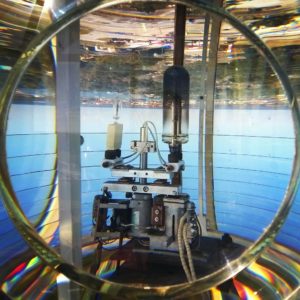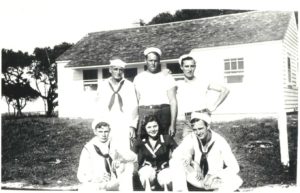This sixth installment in our ongoing series on the history of the St. Augustine Lighthouse focuses on the changeover from the oil lantern to an electric lantern and the experience of the lighthouse and keepers during World War II.
Click the links below to read previous posts in the series:
- Lighthouse History Pre-1874
- Lighthouse History 1874-1894 (Part I)
- Lighthouse History 1874-1894 (Part II)
- Lighthouse History 1894-1914
- Lighthouse History 1914-1934
1934-1954
The introduction of electricity in lighthouses provided the beacons with a strong, steady light source free of the difficulties inherent in the oil lanterns that preceded this new technology. Electric lanterns required no fuel and created no soot, relieving the keepers of most of their nightly responsibilities.

The electric bulbs that illuminate the St. Augustine Lighthouse; if you look closely, you’ll notice that the lens has inverted the background.
Appointed Head Keeper in 1935, Cardell D. Daniels was in charge of the lighthouse when radio electrician T.A. McKee arrived in February 1936 to electrify the St. Augustine Lighthouse. Completed on March 1st, the keepers in St. Augustine were finally able to enjoy the benefits that came with the transition away from the oil lanterns. The lighthouse was the last Florida lighthouse in the Sixth District, which stretched from North Carolina to Florida’s Atlantic Coast, to receive the new electric lamp. In addition to the benefits this modernization afforded the keepers, the new lantern displayed at 20,000 candlepower, approximately 50% more powerful than the kerosene lantern and providing a more visible signal to the local maritime community.
During this upgrading, McKee also replaced the hand wound clockwork mechanism that kept the lens turning with an electric motor, thus further reducing the keepers’ labor. At this point, the technological advances reduced the responsibilities of the keepers to such an extent that the Lighthouse Service eliminated the 2nd Assistant Keeper position at the St. Augustine Lighthouse, leaving two keepers in charge of lighthouse operations.
Merger with the Coast Guard & World War II
U.S. lighthouses have been under various jurisdictions in our country’s history, being at various times operated by the Lighthouse Establishment, Lighthouse Board, or Lighthouse Service. In 1939, the organization responsible for lighthouse construction, maintenance, and operation changed again when the Lighthouse Service merged with the U.S. Coast Guard. The Coast Guard gave the keepers the option to continue serving as civilians or to enlist. Head Keeper Cardell Daniels chose to enlist as a Boatswain’s Mate.
Shortly after the United States entered World War II in December 1941, the St. Augustine Lighthouse closed once again to visitors just as it had during World War I. During the war, lighthouses powerful beacons proved dangerous for the wartime shipping fleet. German U-boats would prowl east of the shipping lanes and wait for cargo ships to pass between them and the coastline. Lighthouses would silhouette the ships, making them easy targets for the Germans.
Only a few years after its transition to electric power, the keepers replaced the lighthouse’s powerful 1000-watt lightbulb with a 50-watt lightbulb in an effort to reduce the risk to coastal shipping. Other U.S. lighthouses took the same precaution.

Some of the Keepers and Coasties in front of the USCG barracks; it now serves as the Lighthouse Archaeological Maritime Program offices.
During the war, the Coast Guard stationed six “Coasties” in a small barracks on site to serve as lookout from the tower’s observation deck at all times. Rifles were stored in the tower in case of invasion. Given what we now know about the outcomes of World War II, storing arms in the lighthouse may seem to be a bit of an overreaction. However, one of only two known incidents of Germans coming ashore on American soil occurred just north of St. Augustine at Ponte Vedra Beach. Although the spies were quickly apprehended after one member of the group turned himself in to authorities, the presence of spies and U-boats underscored the importance of coastal security.
Following the war, operations at the lighthouse returned to normal. Visitors came flooding back as keepers replaced the 1000-watt lightbulb, returning the lighthouse to its full power. Cardell Daniels left the lighthouse in 1943 and I.D. Goodwin took over before handing over responsibilities to James Pippin. Lighthouse operations ran normally through the post-war period, although it wouldn’t be long before everything changed as the Coast Guard continued to modernize the country’s lighthouses.
READ THE NEXT INSTALLMENT OF OUR LIGHTHOUSE HISTORY →
Following the 219-step climb, visitors today can still view the electric bulbs that continue to illuminate the St. Augustine Lighthouse. Come by and see them for yourself!
Paul Zielinski is Director of Interpretation for the St. Augustine Lighthouse & Museum. He received his master’s degree in Public History from the University of West Florida and joined the lighthouse family in 2011.

